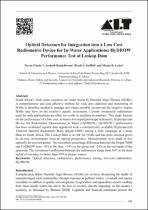 ResearchSpace
ResearchSpace
Optical detectors for integration into a low cost radiometric device for in-water applications: HyDROW performance test at Loskop Dam
JavaScript is disabled for your browser. Some features of this site may not work without it.
- ResearchSpace
- →
- Research Publications/Outputs
- →
- Journal Articles
- →
- View Item
| dc.contributor.author |
Chetty, N

|
|
| dc.contributor.author |
Ramkilowan, A

|
|
| dc.contributor.author |
Griffith, DJ

|
|
| dc.contributor.author |
Lysko, MD

|
|
| dc.date.accessioned | 2013-08-05T07:53:26Z | |
| dc.date.available | 2013-08-05T07:53:26Z | |
| dc.date.issued | 2013-04 | |
| dc.identifier.citation | Chetty, N, Ramkilowan, A, Griffith, D.J and Lysko, M.D. 2013. Optical detectors for integration into a low cost radiometric device for in-water applications: HyDROW performance test at Loskop Dam. European Journal of Remote Sensing, vol. 46, pp 349-361 | en_US |
| dc.identifier.issn | 2279-7254 | |
| dc.identifier.uri | http://server-geolab.agr.unifi.it/public/completed/2013_EuJRS_46_349_361_Chetty.pdf | |
| dc.identifier.uri | http://hdl.handle.net/10204/6925 | |
| dc.description | Copyright: 2013 Italian Society of Remote Sensing. This is an ABSTRACT ONLY. The definitive version is published in European Journal of Remote Sensing, vol. 46, pp 349-361 | en_US |
| dc.description.abstract | South Africa’s fresh water resources are under threat by Harmful Algal Blooms (HABs). A comprehensive and cost effective method for wide area detection and monitoring of HABs is therefore needed to manage and where possible circumvent the negative impact HABs may have on the country’s aquatic ecosystems. Current commercial radiometers used for such applications are often too costly to purchase in numbers. This study focuses on the performance of a low cost, in-house developed prototype radiometer, Hyperspectral Device for Radiometric Observations in Water (HyDROW). HyDROW’s performance has been evaluated against data registered with a commercially available Hyperspectral Tethered Spectral Radiometer Buoy (HyperTSRB) during a field campaign at Loskop Dam in South Africa. The Loskop Dam is at risk for HABs and has been selected given its diverse environments from an optical perspective. Measurements were made at five optically diverse test points. The maximum percentage difference between the HyperTSRB and HyDROW were ~8% in the blue, ~19% in the green and ~24% in the red bands of the spectrum. The correlation coefficients between the radiometers range from 0.97 at the most turbid of test sites, to better than 0.99 in clearer waters. | en_US |
| dc.language.iso | en | en_US |
| dc.publisher | Italian Society of Remote Sensing | en_US |
| dc.relation.ispartofseries | Workflow;11302 | |
| dc.subject | Optical detectors | en_US |
| dc.subject | Radiometers | en_US |
| dc.subject | Performance testing | en_US |
| dc.subject | Low-cost radiometers | en_US |
| dc.subject | HyDROW | en_US |
| dc.subject | Harmful Algal Blooms | en_US |
| dc.subject | HABs | en_US |
| dc.subject | Loskop Dam | en_US |
| dc.title | Optical detectors for integration into a low cost radiometric device for in-water applications: HyDROW performance test at Loskop Dam | en_US |
| dc.type | Article | en_US |
| dc.identifier.apacitation | Chetty, N., Ramkilowan, A., Griffith, D., & Lysko, M. (2013). Optical detectors for integration into a low cost radiometric device for in-water applications: HyDROW performance test at Loskop Dam. http://hdl.handle.net/10204/6925 | en_ZA |
| dc.identifier.chicagocitation | Chetty, N, A Ramkilowan, DJ Griffith, and MD Lysko "Optical detectors for integration into a low cost radiometric device for in-water applications: HyDROW performance test at Loskop Dam." (2013) http://hdl.handle.net/10204/6925 | en_ZA |
| dc.identifier.vancouvercitation | Chetty N, Ramkilowan A, Griffith D, Lysko M. Optical detectors for integration into a low cost radiometric device for in-water applications: HyDROW performance test at Loskop Dam. 2013; http://hdl.handle.net/10204/6925. | en_ZA |
| dc.identifier.ris | TY - Article AU - Chetty, N AU - Ramkilowan, A AU - Griffith, DJ AU - Lysko, MD AB - South Africa’s fresh water resources are under threat by Harmful Algal Blooms (HABs). A comprehensive and cost effective method for wide area detection and monitoring of HABs is therefore needed to manage and where possible circumvent the negative impact HABs may have on the country’s aquatic ecosystems. Current commercial radiometers used for such applications are often too costly to purchase in numbers. This study focuses on the performance of a low cost, in-house developed prototype radiometer, Hyperspectral Device for Radiometric Observations in Water (HyDROW). HyDROW’s performance has been evaluated against data registered with a commercially available Hyperspectral Tethered Spectral Radiometer Buoy (HyperTSRB) during a field campaign at Loskop Dam in South Africa. The Loskop Dam is at risk for HABs and has been selected given its diverse environments from an optical perspective. Measurements were made at five optically diverse test points. The maximum percentage difference between the HyperTSRB and HyDROW were ~8% in the blue, ~19% in the green and ~24% in the red bands of the spectrum. The correlation coefficients between the radiometers range from 0.97 at the most turbid of test sites, to better than 0.99 in clearer waters. DA - 2013-04 DB - ResearchSpace DP - CSIR KW - Optical detectors KW - Radiometers KW - Performance testing KW - Low-cost radiometers KW - HyDROW KW - Harmful Algal Blooms KW - HABs KW - Loskop Dam LK - https://researchspace.csir.co.za PY - 2013 SM - 2279-7254 T1 - Optical detectors for integration into a low cost radiometric device for in-water applications: HyDROW performance test at Loskop Dam TI - Optical detectors for integration into a low cost radiometric device for in-water applications: HyDROW performance test at Loskop Dam UR - http://hdl.handle.net/10204/6925 ER - | en_ZA |





